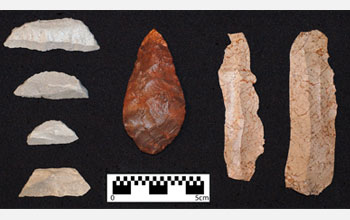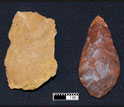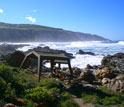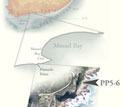News Release 09-152
Early Fire Use Ignites Discussion about the Evolution of Human Brainpower
Researcher talks about discovery of controlled fire use in Africa

Tools created by the experimental use of fire-treated silcrete blocks.
August 13, 2009
Watch an interview with paleoanthropologist Curtis Marean.
This material is available primarily for archival purposes. Telephone numbers or other contact information may be out of date; please see current contact information at media contacts.
New evidence that early modern humans used fire in southern Africa in a controlled way to increase the quality and efficiency of stone tools is changing how researchers understand the evolution of human behavior, and in particular, the evolution of human brain power.
Curtis Marean and Kyle Brown, both paleoanthropologists with the Institute of Human Origins at Arizona State University, and an international team of researchers with members from South Africa, England, Australia and France found 72,000-year-old, silcrete rocks that had been fired and flaked to make stone tools in a cave along the coast of the southern tip of Africa in Mossel Bay.
The finding indicates that humans' ability to solve complex problems may have occurred at the same time their modern genetic lineage appeared, rather than developing later as has been widely speculated.
The journal Science reports the finding in its Aug. 14 issue. The National Science Foundation supports the research.
Read more in the Arizona State University press release at http://asunews.asu.edu/20090813_ancienttoolmakers.
-NSF-
-
View Video
Curtis Marean talks about the discovery of fired and flaked stone tools in southern Africa.
Credit and Larger Version -
Before and after view of silcrete rock heated with fire to make a stone tool.
Credit and Larger Version -
Pinnacle Point sieving area.
Credit and Larger Version -
Geography of Pinnacle Point, Mossel Bay along the South African coast.
Credit and Larger Version -
Science reports evidence that early modern humans used fire to create stone tools.
Credit and Larger Version
Media Contacts
Bobbie Mixon, NSF, (703) 292-8070, email: bmixon@nsf.gov
Carol Hughes, Arizona State University, (480) 965-6375, email: carol.hughes@asu.edu
Program Contacts
Elizabeth Tran, NSF, (703) 292-5338, email: etran@nsf.gov
Principal Investigators
Curtis Marean, Arizona State University, (480) 965-2718, email: curtis.marean@asu.edu
The U.S. National Science Foundation propels the nation forward by advancing fundamental research in all fields of science and engineering. NSF supports research and people by providing facilities, instruments and funding to support their ingenuity and sustain the U.S. as a global leader in research and innovation. With a fiscal year 2023 budget of $9.5 billion, NSF funds reach all 50 states through grants to nearly 2,000 colleges, universities and institutions. Each year, NSF receives more than 40,000 competitive proposals and makes about 11,000 new awards. Those awards include support for cooperative research with industry, Arctic and Antarctic research and operations, and U.S. participation in international scientific efforts.
Connect with us online
NSF website: nsf.gov
NSF News: nsf.gov/news
For News Media: nsf.gov/news/newsroom
Statistics: nsf.gov/statistics/
Awards database: nsf.gov/awardsearch/
Follow us on social
Twitter: twitter.com/NSF
Facebook: facebook.com/US.NSF
Instagram: instagram.com/nsfgov





